|
DEPARTMENT
OF THE ARMY
HEADQUARTERS, 1ST BATTALION, 92D ARTILLERY
APO 96318
AVGG-BJ-C 5
May 1968
SUBJECT: Operational
Report of the 1st Battalion, 92d Artillery for Period Ending 31 July
1968 RCS CSFOR-65 (R1)
See Distribution
SECTION 1. Operations:
Significant Activities
a. (C) General
(1) The 1st Battalion,
92d Artillery remains attached to the 52d Artillery Group, with its
tactical headquarters in Dak To, operating normally in a general support/reinforcing
role throughout the central highlands.
(2) The positions
and mission of the units, currently deployed throughout the 4th Infantry
Division areas of operations, are:
(a) Headquarters
- Grid ZB001214 - Fire Base 1, Dak To.
(b) Headquarters
Rear - Grid ZA226535.
(c) Battery A
- Grid YB93451875 - Fire Base 6, GS/R 6/29th Artillery.
(d) Battery B
- Grid ZA151924 - Fire Base Irma J, GS/R 2/9th Artillery.
(e) Battery C
- Grid AQ771182 - Ban Me Thuot, GS/R 4/42d Artillery.
(f) Service -
Grid AQ226535.
(g) Metro - Grid
ZA004217 - Fire Base 1 DAK TO, supports artillery and air weather
service.
(3) Effective
15 June 1968, the unit began to operate under TO&E 6-425 G (see
inclosure #1). The old and new authorized strengths are:
(a) TO&E
OFF WO EM
TOTAL
6-425-E 30 4 552 586
6-425-G 37 6 555 598
(b) Assigned 31 4 526 561
(4) During this
quarter all units were daily engaged in combat operations completing
15 air moves and 13 road marches into new firing positions. This
made a total of 36 air moves and 74 ground moves since coming in-country
in March of 1967.
(5) During this
quarter 29,067 rounds were fired, or a total of 199,835 rounds fired
since coming in-country. This total includes 348 rounds of Shell
M449, expended on 31 missions.
(b) (C) Significant
activities for the quarter were:
1 May - Btry B,
evaluated by Headquarters, 52d Artillery Group.
3 May - Btry C
moved by air from POLEI KLENG to FSB 15, coordinates YB855188, GS/R
6/29th Artillery. Platoon A/1/92 at DAK PEK, went under operational
control of Detachment B, DAK PEK.
5 May - LTC Cade,
2Lt Petty and 2Lt Lyon assisted the 3rd ARVN Cav in repulsing an
ambush on Highway 14 between PLEIKU and KONTUM. 2Lt Petty was an
aerial observer and the others assisted in fire coordination. LTC
Cade and 2Lt Lyon were subsequently awarded the Vietnamese Gallantry
Cross with Silver Star for their actions.
13 May - Headquarters,
Headquarters, Service and Alpha batteries received a command inspection
by Headquarters, IFFV Artillery.
15 May - Btry
A(-) moved by road from PLEIKU to DAK TO enroute to FSB 6. The 3rd
Bn, 6th Arty then assumed the mission of Pleiku Defense and of liaison
to the 3rd ARVN Cav.
16 May - Btry
B took two 75mm recoiless rifle round hits on number 6 piece, which
remained in action until evacuated. 53 rounds of Shell M449 were
fired in defense of LZ Brillo Pad.
18 May - Btry
C evaluated by Headquarters, 52d Artillery Group.
20 May - Btry
A evaluated by Headquarters, 52d Artillery Group
21 May - Forward
CP, HQ, 1/92 established at FSB 1, DAK TO to assist organic units
and perform liaison duties for HQ, 52d Arty Gp and for Brty B, 6th
Bn, 14th Arty. This move resulted in there being four firing positions,
four rear areas and one forward area being maintained by the 1/92
Arty.
24 May - Platoon
A/1/92 moved by air from DAK PEK to Check Point 104 on Highway 14,
coordinates ZA188993, DS of the 2/1st Cav for highway security.
Move completed by road from DAK TO on 26 May.
25 May - Btry
A(-) and Btry C fired 433 rounds, including 50 Shell M449 in defense
of FSB 15 and 29. Firecrackers credited with breaking up the attack.
27 May - Btry
B, FSB 14, lost one howitzer, one water trailer and took two hits
on the fire direction center from 75mm recoiless rifle. Battery
delivered 151 rounds of counter-battery fire during the battle.
28 May - Platoon
A/1/92 closed at DAK PEK, by air, with one more gun from FSB 6.
Due to conflict with the requirements of Task Force Matthews, at
the close of 28 May one gun was in DAK PEK, one in DAK TO and one
at CP 104.
30 May - Platoon
A/1/92 closed at DAK PEK, coordinates YB958684, GS/R 6/29th Arty
in support of Task Force Cherokee II, composed primarily of the
3rd Bde, 101st Abn Div, with the 2nd Bn, 319th Arty.
1 June - Btry
A, DAK PEK, changed to GS, Free World Forces as 101st Abn departed.
5 June - LTC Jesmond
D. Balmer assumed command of 52d Arty GP form COL Hal Hallgren.
7 June - LTC Henry
E. Strickland Jr. assumed command of the 1st Bn, 92d Arty from LTC
Alfred J. Cade.
15 June - Btry
B moved 4 guns by air from FSB 14 to Bunker Hill, coordinates YA996825,
GS/R 2/9th Arty. HQ/1/92 now manned the fire directions centers
on FSB 6 and Bunker Hill.
17 June - Btry
C moved by air from FSB 15 to FSB 1, DAK TO, coordinates ZB004215,
GS/R 6/29th Arty. Because of a shortage of air assets one gun and
the co-located radar did not close at DAK TO until 19 June.
20 June - Platoon
B/1/92 moved from FSB 14 by air to Polei Kleng and thence by road
to KONTUM, enroute Pleiku.
21 June - Platoon
B/1/92 moved by road from KONTUM to Artillery Hill, PLEIKU, to assist
in the Pleiku Defense (coordinates ZA22745355).
1 July - Btry
B(-) departed Bunker Hill by air for POLEI KLENG to FSB THUNDER,
coordinates ZA147897, GS/R 2/9th Arty.
7 July - Btry
B(-) moved by road from POLEI KLENG to FSB THUNDER, coordinates
ZA147897, GS/R 2/9th Arty, pending construction of FSB MURIEL.
10 July - Btry
B(-) fired demonstration for forward observers of 3rd Bde, 4th Inf
Div. During the demonstration 3 Shell M449 were fired at the same
point, the first two of which functioned well. The third round was
a dud, the first malfunction observed in 348 rounds fired. A patrol
from the 1st Bn, 14th Inf was unable to locate the round on 11 July.
13 July - Btry
C moved by air from DAK TO to the Special Forces Camp at DAK SEANG,
coordinates YB902409, assumed mission was (?) 42nd ARVN Regt.
16 July - Btry
C(-) moved by air from DAK SEANG to YB906452, CO-located with HQ,
42nd ARVN Regt. Battery supported 4 CIDG companies and the 2nd Bn,
42nd ARVN Regt in searching an area vicinity coordinates YB9749
to 9947 for a reported 12 to 40 tons of munitions. 883 rounds were
fired in support of the operation. Target acquisition, aerial observation
and liaison was provided to the 42nd ARVN Regt by HQ/1/92 Arty.
16 July - Btry
B(-) moved by road from FSB THUNDER to FSB MURIEL, coordinates ZA137913,
GS/R 2/9th Arty.
21 July - One
gun A/1/92 moved by air from DAK PEK to FSB 6.
22 July - Two
guns A/1/92 moved by air from DAK PEK to FSB 6. Move not completed
due to weather and limited aircraft support.
23 July - Btry
A closed at FSB 6 from DAK PEK, GS/R 6/29th Arty.
23 July - Platoon
B/1/92 moved by road to coordinates AR776439 to practice special
munitions demonstration for II CTZ. 8 Shell M449 functioned well.
Platoon returned to Artillery Hill for the night.
24 July - Platoon
B/1/92 returned by road to demonstration firing point. Demonstration
postponed due to weather. Platoon returned to Artillery Hill.
24 July - Btry
C moved by road from DAK TO to Artillery Hill, PLEIKU, coordinates
ZA22535373, GS Pleiku Defense.
25 July - Btry
C moved by road from PLEIKU to BAN ME THUOT, coordinates AQ88(9?)015,
GS Free World Forces, priority of fire to the 4/42d Arty.
27 July - 6/14th
Arty took operational control of B/1/92.
27 July - 5/22d
Arty took operational control of C/1/92.
27 July - Btry
C moved by road to coordinates AQ771182, GS Free World Forces, priority
of fire to 4/42d Arty.
28 July - Platoon
B/1/92 moved by road from Artillery Hill to FSB MURIEL, coordinates
ZA137913, to reunite battery, GS/R 4/42d Arty.
29 July - Btry
B moved by air and road from FSB MURIEL to FSB IRMA J, coordinates
ZA151924, GS/R 2/9th Arty.
29 July - Btry
C mission changed to GS/R 4/42d Arty.
2. (U) Section 2,
Lessons Learned: Commander's Observations, Evaluation, and Recommendations.
a. Personnel: None
b. Operations:
(1) Extraction of
water from hydrogen.
(a) OBSERVATION.
Meteorological sections are constantly plagued by water mixing with
the hydrogen that inflates sounding balloons.
(b) EVALUATION.
Due to atmospheric conditions, water invariably forms inside the
hydrogen gas cylinders. To reduce the amount of hydrogen required
to inflate the sounding balloon and to reduce the possibility of
the balloon bursting from the atmosphere heated water, the water
should be drawn from the hydrogen during the inflation process.
Although no condensor is issued, the following method may be used
to draw the water out of the hydrogen during inflation (refer to
attached sketch). Take one piece of 3 inch or larger pipe, 20 inches
long, and seal both ends. Drill a ½ inch hole approximately
4 inches from each end and weld into each hole a 6 inch length of
½ inch pipe (outer diameter). Drill a hole in one end of
the 3 inch pipe and weld in a drain cock. Attach or weld on a weight
to the cylinder. Attach the inflating hose of the TM Q-3 manifold
to one of the ½ inch pipes, and the hose of the inflation
nozzle to the other ½ inch pipe. Submerge the pipe apparatus
(condensor) in a drum of cold water and feed the gas into the balloon.
After inflation, drain out the condensed water.
(c) RECOMMENDATION.
That all meteorological units should consider purifying hydrogen
for inflating sounding balloons through a condensation process.
(See Incl 2.)
(2) Utilization
of terminal box TA 125/GT.
(a) OBSERVATION.
Standard terminal strips (TM-184) are not effective in high humidity
and wet monsoon areas.
(b) EVALUATION.
Standard terminal strips are often affected by moisture and can
accommodate only 7 lines. Terminal Box TA 125/GT with a water tight
seal, and accommodations for 12 lines makes an excellent all weather
terminal strip.
(c) RECOMMENDATION.
That those units authorized only TA-184 terminal strips acquire
18 terminal boxes TA 125/GT, allocating 10 to Battalion Communications
and 2 each to A, B, C and Service Batteries to insure continuous
communications.
(3) Dangerous sandbags.
(a) OBSERVATION.
The new green plastic sandbags, FSN 8105-926-2035, (Bag, Sand Poly)
are not safe to use in most construction work.
(b) EVALUATION.
The new green plastic sandbags have been used to form low bunker
walls and to protect building walls. In both cases, after the first
substantial rainfall each type of wall invariably collapsed, the
bags sliding like ice cubes.
(c) RECOMMENDATION.
That the new green plastic sandbags be used only to protect roof
structures and then no more than two (2) layers high.
(4) Use of bulldozer.
(a) OBSERVATION.
Previous lessons learned indicated the value of a bulldozer in preparing
artillery positions. A bulldozer is also invaluable as a prime mover
of light and medium howitzers.
(b) EVALUATION.
CH-54 Skycrane operators are not always able to drop a heli-lifted
howitzer where it is needed. Many fire bases are such that man-handling
is either impossible or impractical. Using the bulldozer that is
on-site to prepare the position as a prime mover can be a life-saver.
(c) RECOMMENDATION.
That if a bulldozer is used to prepare an artillery position it
should be kept on-site until all heavy equipment is in place.
(5) Grid zone convergence.
(a) OBSERVATION.
The convergence of grid zones 48 and 49 throughout western Viet
Nam is a constant problem for survey and fire direction. It is occasionally
overlooked with disastrous results.
(b) EVALUATION.
Unless firing charts accurately account for the convergence of grid
zones 48 and 49, a deflection error of as many as 27 mils and a
variable range error may be introduced into the firing data. There
are several accurate methods of compensating for this convergence
but the primary factor is to insure that you have a system that
forces consideration of convergence.
(c) RECOMMENDATION.
1 That all
survey data computed for firing batteries in western Viet Nam show
the location of the battery center in both grid zones, stating "none"
when it does not apply.
2 That all fire direction officers when they receive grid coordinates,
inspected or surveyed of battery center, automatically question
which zone they apply in.
3 That all M18 computer (FADAC) operators be trained to automatically
expect to enter two battery centers every time they enter data and
to question it when it is not offered.
(6) Use of the 3
KW, 400 cycle generator for illumination purposes.
(a) OBSERVATION.
Units are doing without electrical illumination, while the 3 kW,
400 cycle FADAC generators are idle.
(b) EVALUATION.
Standard 1.5 and 3 kW generators are often down for maintenance
or unavailable due to supporting non-TO&E requirements. This
puts some command posts and fire direction center in the dark. It
has been found that while M-18 computers are down for maintenance,
the 3 kW 400 cycle generators are an excellent power source. It
must be remembered though that when the M-18 computer is on line,
nothing else may be connected to its generator.
(c) Training:
(1) Rigging of pierced
steel planking/solid steel planking for helilift.
(a) OBSERVATION.
When PSP/SSP is heli-lifted at the same or higher height than an accompanying
load, the PSP/SSP invariably cuts through the other sling.
(b) EVALUATION.
This is an old lesson that remains unlearned through rotation. A newly
assigned person who is not experienced in heli-lift operations normally
does not think that it makes any difference which load is suspended
by a 20 foot sling and which by the shorter sling. However as indicated
in the diagram, when the PSP/SSP rides above another load, the swaying
motion to of the steel edges cut through the longer sling leaving
a load in the jungle or endangering people below.
(c) RECOMMENDATION.
When lifting PSP/SSP in conjunction with other cargo, the PSP/SSP
should be suspended from a 20 foot sling and the other cargo from
a shorter sling such as an 11 foot, 9 foot or 20 foot sling doubled.
This prevents the steel from cutting the other sling and in addition
permits the PSP/SSP to land first so as not to crush the other load.
While it has been found that shipping 30 sheets of PSP/SSP with one
load of section equipment reduces the sorties required to move a unit,
shipping a maximum of 40 sheets of PSP/SSP as one load by the CH-47
Chinook also eliminates the sling cutting problem. (See Incl 3.)
(2) Rigging of ammunition
on board vehicles.
(a) OBSERVATION.
Without careful planning, ammunition is often handled more than once
which causes delay in heli-lift operations.
(b) EVALUATION.
If howitzer ammunition is picked up, brought to the pick-up zone (PZ)
and placed in nets it is handled twice and wreckers may be required
at both places. Further, if the aircraft commander finds the pickup
zone unsatisfactory, or the move is not completed, then the ammunition
must be handled again.
(c) RECOMMENDATION.
That all howitzer ammunition be placed in cargo nets initially on
board the ammunition vehicle and lifted directly from the truck. This
facilitates transportation, reduces the need for wreckers and yields
a mobile PZ, Figures I, II and III indicate three approaches to lifting
out as much as 15(?) complete 155mm rounds from one 5 ton truck. Figures
I and II pertain to palletized powder and projectiles and figure III
to palletized projectiles and loose green bag propellant cannisters.
In all cases the projectiles come eight to a pallet, six pallets to
a load with two loose projectiles wired together for security, making
fifty (50) rounds to a load. Fifty (50) fuzes are shipped with the
projectiles. (See Incl 4.)
(3) Heli-lifting
vehicles.
(a) OBSERVATION.
In spite of training and precautions, non-flexible fixed parts of
vehicles continue to be damaged during movement.
(b) EVALUATION.
Most units prepare vehicles for external loading under helicopters
the same way. Windshields are down, bows and canvass are removed,
mirrors are tucked in and four slings of equal length are evenly distributed
around the vehicle. A two man hook-out team is used, that normally
remains on-board or near the vehicle until it is lifted out to insure
that no sling gets fouled in the load. The problem arises when the
aircraft slacks off after having pt strain on the slings and load
to get under a mirror arm, door handle or steering wheel and either
pitch over the load or bend the item out of shape.
(c) RECOMMENDATION.
That the controller of the hook-out-team stay in position to kill
the lift out signal and the other man stay near the vehicle until
the aircraft is in full flight.
d. Intelligence: None
e. Logistics
(1) Delivery of
ammunition by low level extraction (LOLEX)
(a) OBSERVATION.
To reduce air time for CH-47 Chinooks, forward ammunition supply points
may be established and then serviced by C-130 Hercules delivering
howitzer ammunition by parachute in the low level extraction technique.
(b) EVALUATION.
One experience with LOLEX indicated it was worthy of continued experimentation.
It did shorten air time for the Chinooks but it also created some
problems such as dented powder cannisters which made the powder unserviceable.
The widely scattered pallets increased the security requirement and
effort required to assemble and prepare Chinook loads. The back-hauling
and accountability of the special Air Force rigging materials was
another difficulty.
(c) RECOMMENDATION.
That the above difficulties be considered in future use of the LOLEX
system for ammunition resupply.
(2) Substitute water
containers.
(a) OBSERVATION.
Powder cannisters make excellent non-potable water containers.
(b) OBSERVATION.
Powder cannisters make excellent non-potable water containers.
(b) EVALUATION.
Due to many circumstances such as split units (batteries), damaged
water trailers, punctured blivets and no back-haul of water cans,
alternate means of transporting water are necessary. Powder Cannisters
such as for charge propellant M4A1 (155mm white bag) are water tight,
hold three gallons of water and can take rough handling.
(c) RECOMMENDATION.
That powder cannisters, which are easily air transportable, be used
as substitute non-potable water containers.
f. Organization: None
g. Other: None
Henry E. Strickland, Jr.
4 Incl LTC,
Artillery
1. Organizational Chart Commanding
2, 3, 4
Illustrations
DISTRIBUTION:
2 ea. CINCUSAR PAC
ATTN: GPOP-DT
APO 96558
3 ea. Commanding
General
USARV
ATTN: AVHGC
APO 96375
6 ea. Commanding
Officer
52d Arty GP
ATTN: S-3
APO 96318
AVGG-CO (1 Aug 68)
1st Ind
SUBJECT: Operational Report of 1st Battalion, 92d Artillery for Period
Ending 31 July 1968 RCS
CSFOR-65 (R1) (U)
DA, HQ, 52d Artillery
Group, APO 96318 16 August 1968
TO: Commanding General,
I FFORCEV Artillery, APO 96350
(U)
I Concur in the contents of basic report. Nonconcur with Section 2,
Lessons Learned b (6). Use of 3KW 400 cycle FADAC generator to provide
power for lighting contributes to existing problem of nonoperational
FADAC's due to generator breakdown. Generator should be employed to
power equipment for which it is designed.
Jesmond
D. Balmer Jr.
Colonel,
Artillery
Commanding
AVFA-AT-D (1 Aug 68)
2d Ind
SUBJECT: Operational Report of the 1st Battalion, 92d Artillery for
Period Ending 31 July 1968, RCS:
CSFOR-65 (R1)
DA, HEADQUARTERS,
I FIELD FORCE VIETNAM ARTILLERY, APO 9635O 26 Aug 1968
TO: Headquarters,
I Field Force Vietnam, APO 96350
(C) This headquarters
has reviewed the attached Operational Report with indorsement and
concurs with all recommendations as indorsed with the following exceptions:
Reference paragraph
2b(2)(c), page 7, Utilization of Terminal Box TA125/GT. Nonconcur.
Proper installation, maintenance, and the provision of a protective
covering to prevent direct exposure to the weather will keep the TM-184
terminal strips operational.
FOR THE COMMANDER:
Gearld
C. Young
Major,
Artillery
Adjutant
AVFA-GC-OT (5
May 68) 3d
Ind
SUBJECT: Operational Report of 1st Battalion, 92d Artillery for Period
Ending 30 April 1968 RCS
CSFOR-65 (R1)
DA, HEADQUARTERS,
I FIELD FORCE VIETNAM, APO 96350 29 May 1968
TO: Commanding General,
United States Army Vietnam, ATTN: AVHGC-DST, APO 96375
Concur.
FOR
THE COMMANDER:
Robert
C. Gabbard
Copy furnished 1LT,
AGC
IFFORCEV Arty Asst
Adjutant General
AVHGC-DST (1 Aug 68)
4th
Ind (U) MAJ Klingman/hga/LBN 4433
SUBJECT: Operational Report of 1st Battalion, 92d Artillery for Period
Ending 31 July 1968 RCS
CSFOR-65 (R1)
HEADQUARTERS, UNITED
STATES ARMY VIETNAM, APO SAN FRANCISCO 96375 18
sep 1968
TO: Commander in Chief,
United States Army, Pacific, ATTN: GPOP-DT, APO 96558
This headquarters
has reviewed the Operational Report-Lessons Learned for the quarterly
period ending 31 July 1968 from Headquarters, 1st Battalion, 92d Artillery,
and concurs with the report as modified by the preceding indorsements.
FOR
THE COMMANDER:
W.
C. Arntz
1Lt
AGC
Assistant
Adjutant General
Cy furn:
HQ, I FFV
HQ, 1st Bn, 92d Arty
GPOP-DT (1 Aug 68) (U) 5th
Ind
SUBJECT: Operational Report of 1st Battalion, 92d Artillery for Period
Ending 30 April 1968, RCS
CSFOR-65 (R1)
HQ, US ARMY, PACIFIC,
APO SAN FRANCISCO 96558 8
OCT 1968
TO: Assistant Chief
of Staff for Force Development, Department of the Army, Washington,
D.C. 20310
This headquarters
has evaluated subject report and forwarding indorsements and concurs
in the report as indorsed.
FOR
THE COMMANDER IN CHIEF
C.
L. Short
CPT,
AGC
Asst
AG
ORGANIZATIONAL
CHART
1st Battalion, 92d Artillery
INCLOSURE
1
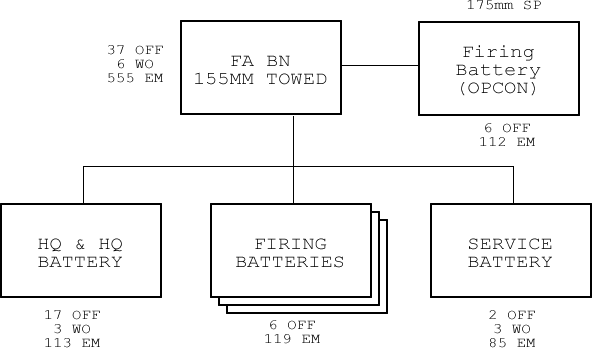
INCLOSURE 2
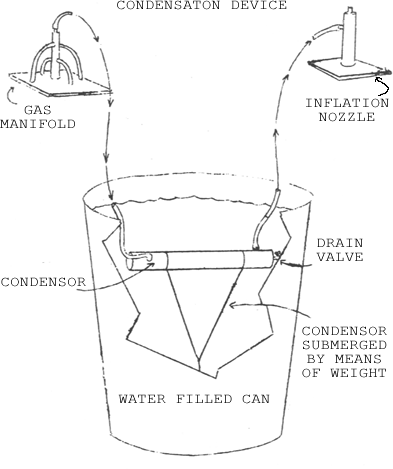
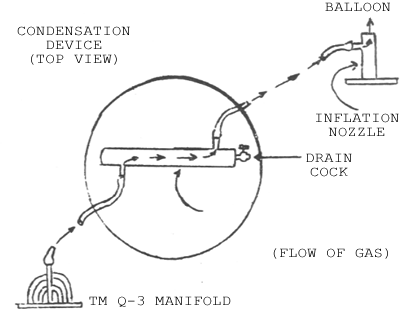
INCLOSURE
3
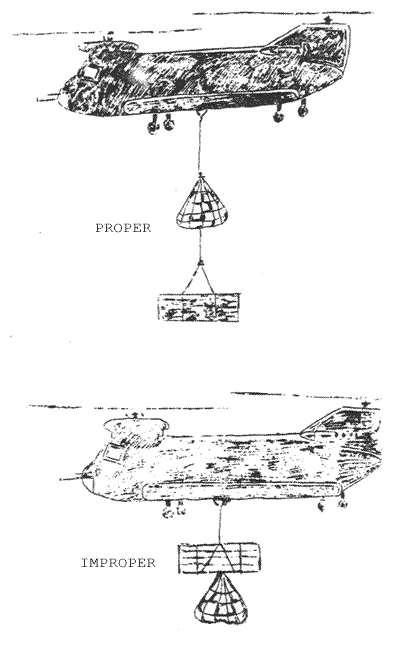
INCLOSURE 4
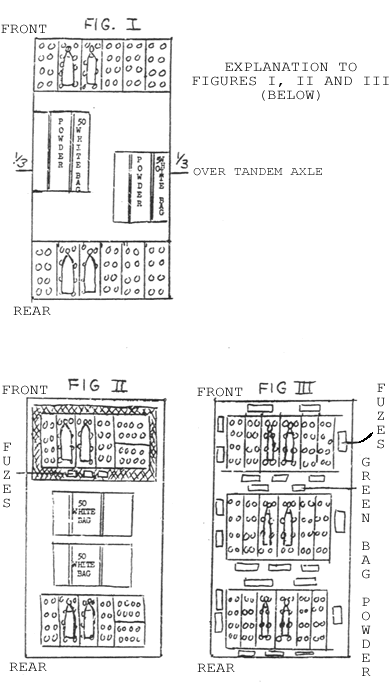
EXPLANATION
TO FIGURES I & II
1 Load Powder first.
2 Sling powder with two 20 foot slings for each pallet.
3 Lay out a cargo net at each end of the bed.
4 Load projectiles
and fuzes.
5 Sling up nets and attach loads to respective powder pallets.
6 REMARKS: When loading powder, leave enough room for swaying. Use 9
foot sling or twenty (20) foot sling doubled for all projectile loads.
EXPLANATION
TO FIGURE III
1 Lay out three (3) cargo nets in bed of truck.
2 Load projectiles in each net.
3 Lay 25 cannisters of green bag and three (3) boxes of fuzes around
projectiles.
4 Sling loads with 9 foot or double 20 foot sling.
|